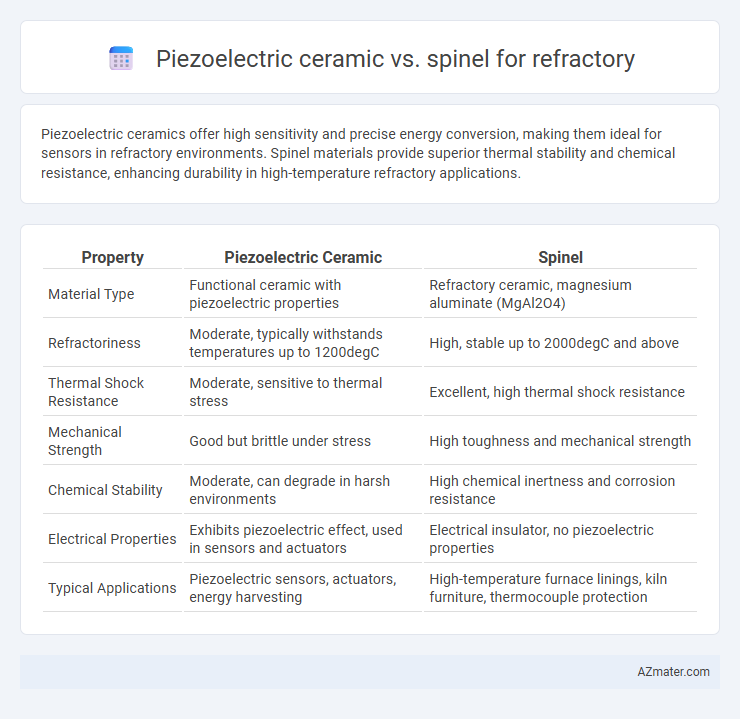Piezoelectric ceramics offer high sensitivity and precise energy conversion, making them ideal for sensors in refractory environments. Spinel materials provide superior thermal stability and chemical resistance, enhancing durability in high-temperature refractory applications.
Table of Comparison
| Property | Piezoelectric Ceramic | Spinel |
|---|---|---|
| Material Type | Functional ceramic with piezoelectric properties | Refractory ceramic, magnesium aluminate (MgAl2O4) |
| Refractoriness | Moderate, typically withstands temperatures up to 1200degC | High, stable up to 2000degC and above |
| Thermal Shock Resistance | Moderate, sensitive to thermal stress | Excellent, high thermal shock resistance |
| Mechanical Strength | Good but brittle under stress | High toughness and mechanical strength |
| Chemical Stability | Moderate, can degrade in harsh environments | High chemical inertness and corrosion resistance |
| Electrical Properties | Exhibits piezoelectric effect, used in sensors and actuators | Electrical insulator, no piezoelectric properties |
| Typical Applications | Piezoelectric sensors, actuators, energy harvesting | High-temperature furnace linings, kiln furniture, thermocouple protection |
Introduction to Piezoelectric Ceramics and Spinel in Refractories
Piezoelectric ceramics, known for their ability to generate electric charge under mechanical stress, offer unique sensing and actuation capabilities in refractory applications where precise monitoring of stress and temperature is critical. Spinel, a magnesium aluminate compound (MgAl2O4), is widely used as a refractory material due to its excellent thermal stability, high corrosion resistance, and mechanical strength at elevated temperatures. Comparing piezoelectric ceramics to spinel in refractories highlights their complementary roles: piezoelectric ceramics contribute functional sensing properties, while spinel provides structural integrity and superior performance in harsh thermal environments.
Chemical Composition: Piezoelectric Ceramics vs Spinel
Piezoelectric ceramics primarily consist of lead zirconate titanate (PZT) compounds, characterized by a perovskite crystal structure with elements like lead, zirconium, and titanium, enabling strong piezoelectric properties. Spinel refractory materials are composed predominantly of magnesium aluminate (MgAl2O4), exhibiting a cubic crystal lattice that provides excellent thermal stability and chemical inertness. The distinct chemical compositions directly influence their applications; piezoelectric ceramics excel in sensing and actuation due to their electromechanical coupling, while spinels are favored in high-temperature refractory environments for their resistance to thermal shock and corrosion.
Structural Properties and Phase Stability
Piezoelectric ceramic exhibits superior phase stability under high-temperature conditions compared to spinel, maintaining its tetragonal ferroelectric phase critical for reliable piezoelectric performance. Spinel shows excellent structural robustness with a cubic crystal system, providing high thermal shock resistance but lacks the intrinsic piezoelectric properties found in piezoelectric ceramics. The distinct crystal lattice arrangements directly influence their mechanical strength and dimensional stability, making piezoelectric ceramics preferable for applications demanding precise electromechanical responses, while spinel excels in extreme refractory environments requiring structural integrity.
Thermal Resistance Comparison
Piezoelectric ceramics typically exhibit higher thermal stability with operating temperatures up to 350degC to 400degC, making them suitable for applications demanding moderate thermal resistance. Spinel refractories, composed primarily of magnesium aluminate (MgAl2O4), withstand extreme temperatures exceeding 1800degC due to their excellent structural integrity and thermal shock resistance. In high-temperature environments, spinel materials outperform piezoelectric ceramics in maintaining mechanical strength and thermal insulation properties.
Mechanical Strength and Durability
Piezoelectric ceramics exhibit higher mechanical strength and superior resistance to thermal shock compared to spinel, making them more durable under extreme refractory conditions. Spinel offers excellent chemical stability and resistance to corrosion but generally has lower fracture toughness and mechanical strength than piezoelectric ceramics. Consequently, piezoelectric ceramics are preferred in applications requiring enhanced durability and mechanical performance in high-temperature environments.
Electrical Properties in Refractory Applications
Piezoelectric ceramics exhibit high dielectric constants and strong electromechanical coupling, making them highly sensitive to electrical signals in refractory applications requiring precision sensing and actuation. Spinel materials offer superior electrical insulation and thermal stability, essential for maintaining consistent electrical properties under extreme temperatures in industrial refractory environments. The choice between piezoelectric ceramics and spinel depends on the need for active electrical responsiveness versus passive electrical insulation in high-temperature refractory systems.
Corrosion and Chemical Attack Resistance
Piezoelectric ceramics exhibit moderate corrosion resistance but may degrade under aggressive chemical attack, limiting their use in highly corrosive refractory environments. Spinel refractories, composed primarily of magnesium aluminate, offer superior corrosion resistance against slags and molten metals, maintaining structural integrity under harsh chemical conditions. The inherent chemical stability and high alkali resistance of spinel make it the preferred choice for refractory applications exposed to extreme corrosive media.
Manufacturing Process and Cost Implications
Piezoelectric ceramics require complex sintering processes involving precise temperature control and electrode application, increasing overall manufacturing costs compared to spinel, which benefits from simpler solid-state reaction synthesis. Spinel's high thermal stability and lower sintering temperatures reduce production time and energy consumption, resulting in cost-effective scalability for refractory applications. The choice between piezoelectric ceramics and spinel hinges on balancing performance needs against manufacturing complexity and budget constraints in refractory production.
Typical Industrial Applications and Use Cases
Piezoelectric ceramics are extensively used in industrial sensors, actuators, and precision ultrasonic devices due to their high electromechanical coupling and sensitivity, making them ideal for applications requiring rapid response and durability under mechanical stress. Spinel refractories, composed mainly of magnesium aluminate, excel in high-temperature environments such as furnace linings, kiln furniture, and thermal insulation, offering exceptional thermal shock resistance and chemical stability in steelmaking, glass production, and cement manufacturing. While piezoelectric ceramics focus on sensing and actuation in electronics and mechanical systems, spinel materials are preferred for their structural integrity and longevity in harsh thermal and chemical industrial processes.
Selection Criteria: Choosing Piezoelectric Ceramics or Spinel
Piezoelectric ceramics offer high sensitivity and precise control in refractory applications requiring dynamic stress-response, making them ideal for sensors and actuators in harsh environments. Spinel provides superior thermal stability, chemical resistance, and mechanical strength, essential for structural components exposed to extreme temperatures. Selection hinges on operational requirements: choose piezoelectric ceramics for responsive electronic functionality and spinel for durability and longevity under high thermal and mechanical stress.

Infographic: Piezoelectric ceramic vs Spinel for Refractory
 azmater.com
azmater.com